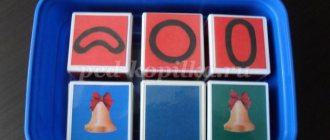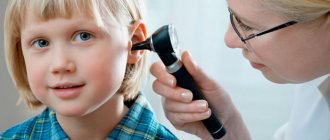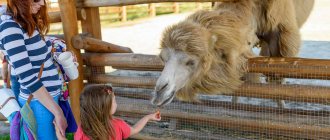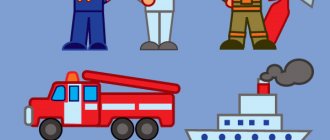Levina E.V., teacher-speech therapist of preschool educational institution, Neryungri, Republic of Sakha (Yakutia) OBJECTIVES OF THE LESSON - To teach children to highlight in sentences and correctly use the preposition from under, to clarify its spatial meaning. — Strengthen the ability to analyze a sentence and implement its diagram. — Develop auditory and visual attention, thinking, and the ability to navigate in space. — Foster a sense of mutual assistance, support, and the ability to work in a subgroup. EQUIPMENT 1. Toy snowman, trees, snowflakes, furniture. 2. Sentence diagrams (individual), plot pictures. 3. Audio recording with wind noise, tape recorder. PREPARATION 1. Children become familiar with the prepositions in, on, under, to, with, from. 2. The teacher conducts a conversation about the winter forest. 3. Exercises are done to analyze sentences and their diagrams are carried out. * * * Organizational moment Children sit in a group. There is a knock on the door. The teacher brings in the snowman. Speech therapist. A snowman came running to us from the winter forest. Something bad happened there. (Includes audio recording with wind noise.) A north wind blew in, blew away the snowflakes, and now the trees are frozen without snow. Why do you think this happens? Children. Snow serves as a blanket for the trees; it retains heat. Psychogymnastics Speech therapist. Imagine how cold it is for the trees and how cold it is for us. Children tense their entire body muscles. Do you enjoy feeling the cold? Children. No. Speech therapist. What should you do to keep warm? Children. We need to move. (Perform several energetic movements.) Speech therapist. We have warmed up, and now we need to help the winter forest. What should we do? There is a large snowflake on the carpet, with a message from the wind written on it. (Reads the message.) “In order for the snowflakes to fly back, you need to complete tasks. For every correct answer I will return snowflakes to the trees.” Repetition of what has been covered Speech therapist. And here is the first task. Remember and name the prepositions of movement. Schemes of prepositions to, from, with are placed on the typesetting canvas. Make a sentence based on the pictures using these prepositions. Three children receive pictures of a kitten, a bear cub and a squirrel. What preposition did Dima use in the sentence? Dima. Preposition to. The kitten ran up to the boy. Speech therapist. Now let's listen to Nastya. Nastya. I have an excuse from. The bear cub came out of the forest. Speech therapist. What happened to Vanya? Vania. I used the preposition s. The little squirrel jumped off the stump. After completing the task, the speech therapist gives the children several snowflakes to hang on the trees. Introduction to the topic Speech therapist (takes a large snowflake). Guys, the wind sent us a riddle about where the snowflakes are hidden, and the clue will be a diagram of the preposition under. (Puts the diagram on the typesetting canvas.) There are four legs under the roof, On the roof there is soup and spoons. Children. It is a table. Speech therapist. Guys, where should we look for snowflakes? Children. Under the table. (They take out snowflakes.) Speech therapist. So where did the wind hide the snowflakes? Children. Under the table. Speech therapist. Where did you get the snowflakes? Can you say it's from the table? Can you say it's from the table? Children. No. Speech therapist. How to say it correctly? Let's think together. Where were the snowflakes? Children. Under the table. Speech therapist. What did we do when we found snowflakes? Children. We took them and raised them. Speech therapist. Two prepositions are combined here. The pretext under and some other pretext of movement. Let's try to connect them and decide how to say it correctly. (Connects the patterns of prepositions and offers the children possible answers.) We took out the snowfields from under (from under, from under) the table. Children choose the correct answer. (Shows a diagram of a new preposition and explains its meaning.) When an object is under something and moves from there, the preposition from under appears. Dynamic pause The speech therapist invites the children to sweep the snowflakes from under the table, chair, or closet. Children imitate the appropriate movements. Then each of them tells what they swept the snowflakes out from under. Consolidating new material There is a set of children's furniture on the table in front of the children. Speech therapist. While we were getting acquainted with the new pretext, the north wind opened the window and hid the snowflakes under what? Children. Under the furniture. Speech therapist. Each of you must take out a snowflake and tell where you got it from. What excuse will help us with this? Children. An excuse from under. (Complete the task and decorate the trees with snowflakes.) Work on individual cards Children make up sentences on individual cards, checking whether they have used the correct preposition. The preposition diagram is covered with a card, and children open it only after voicing their proposal. After each correct answer, the speech therapist decorates the tree with a snowflake. Two or three sentences are analyzed in detail, and a diagram is drawn up for them. One child works at the flannelgraph. Speech therapist. Guys, why do we need prepositions? (Removes the chip indicating a preposition from the diagrams.) Try repeating the sentence without a preposition. Children. The ball rolled out... of the table. Etc. Speech therapist. Do you understand what this sentence says? Children. No. Speech therapist. This means that we can conclude that prepositions help to understand a sentence and help to make friends with words in a sentence. Work in subgroups Children are divided into two teams. Each team receives a panel with fragments of plots. It is necessary to choose from six plots those for which you can make sentences with the preposition from under, and substitute its diagram for the picture. After completing the task, a mutual check is carried out. Teams receive snowflakes and decorate trees with them. Result of the speech therapist lesson. Guys, look, all the trees are covered in snow. Now they are not afraid of frost. What excuse helped us complete our assignments? What was the most difficult task? And the most interesting? What are prepositions for? Children answer questions. Psychogymnastics Speech therapist. Children, the trees are now warm and cozy, they will not freeze in winter. We will now hold hands, feel the warmth of our hands, smile at each other. Children complete the task.
Publications on speech therapy
Goals:
1) clarifying the semantics of prepositions;
2) consolidate knowledge about prepositions at a practical level; 3) consolidating the use of prepositions in oral speech; Equipment:
pencils, diagram, punched cards, pens, notebooks, demonstration material.
1. Organizational moment.
The speech therapist invites students to come up with one sentence of 1-2-3 words.
2. Preposition as an independent word.
The speech therapist asks students to complete the following tasks.
Place the pencil on the notebook. Put the pencil in the notebook. Place a pencil under your notebook. Put down the pencil…..book. The speech therapist explains: “You are finding it difficult to complete the last task only because I missed one little word. Guess what word I missed." The speech therapist then continues, “Put your pencil on the book. (The task is being completed.) Put down the pencil….book. What words are missing? (On the)". Then the same tasks are repeated, but prepositions are not named. Students name the missing preposition each time. Why are prepositions needed?
To construct a sentence correctly, you need to remember small but very important words, without which the sentence loses its meaning.
These words are called prepositions. Guys, guess what the topic of our lesson is? Prepositions What prepositions do you know? Simple - by, in front of, with, from, about, on, behind, at, under, with, to, over, in, from. Complex - (0 (about), (about), between, around, before, for, without, because of., through, near, from under, through, about 3. Consider the diagram, answer the questions? Where is the ball
? ?
4. Assignment.
Near each house, write down a preposition corresponding to the picture.
5. Using a poem to remember the rule. We can put it ON the table, We can put it UNDER the table, We can sit AT the table- Separately write “TABLE!”
If they dictate to us: ON THE TABLE- Here we will write two words: ON THE RIVER, ON THE LAKE, ON THE MOUNTAIN - We separate the preposition again.
There are flowers on the window In pots, ON the table There is water in the decanter, There are black dots on the leaf - Always separate prepositions! 6.
Insert prepositions into sentences.
(Before reading, do an exercise on the strength of your voice)
The handkerchief is in ____ pocket. The kettle is boiling ____ the stove. Katya _____brother drank juice. Fish soup is cooked ___fish. The grandchildren came to ___grandmother. The snake crawled ____the ground. The boy hid ___tree. Smoke is coming from ______ pipes. Mushrooms grow ____ forest. The boy is standing ____the bridge. The granddaughter came ____grandmother. The dog ran away ____the owner. The children played ___ hide and seek
Physical education minute.
7. Make sentences from these words.
The ducks sat on the lake. Mushrooms are collected in a basket. Mom went for a walk with her daughter. Cucumbers are ripening in the garden. Products are bought in a store. There are large puddles on the road. The pies were taken out of the oven. Cars are driving along the road. Kolya walked up to the house. There were apples hanging on the branches. The cat ran after the mouse. There is a picture hanging on the wall.
8. Parse the sentences.
Comparison of Russian and Nenets languages. a) The child is sitting on the sled.
(Child sit on the high sledge) Ңatseky khan, ninya ңamdy.
b) The thimble is in the bag.
(The thimble lies in a beautiful bag.) Gumbya cloud.
munya ңa,. c) Mom hid behind the tent.
(Mom hid behind the summer tent.) Nebyami myad, tyakha lyngarey,,.
9. Correct Carlson's mistakes.
Mom and her daughters went for a walk.
The hat flew off my head. The cat jumped off the roof. The ball rolled downhill. A cat with kittens laps milk. Svetka flew off the plane. 10. Exercise.
Open the brackets. (U) ducklings swam, (u) kittens ran, (u) rabbits galloped, (u) eagle (u) eaglets flew.
(from) the little hare jumped (from) the birch tree. (from) the eaglet flew (from) the nest. (from) the children ran (from) the path. The water came (from) the shore.
11. Summary of the lesson.
— 05/11/2013 (23:14) Author Yulia Timofeevna Kolesnik
yuly-kolesnik[@]yandex.ru





